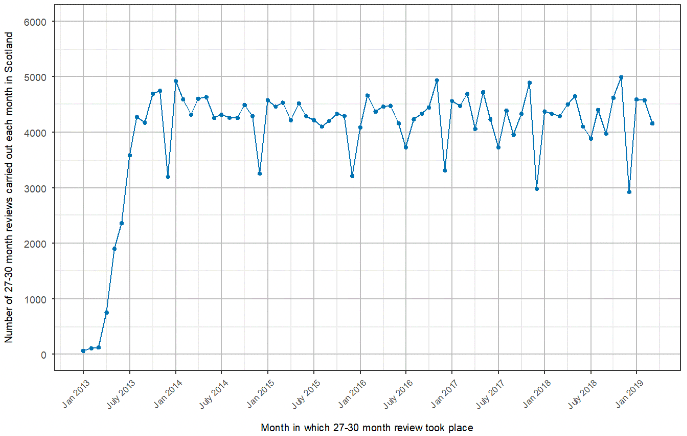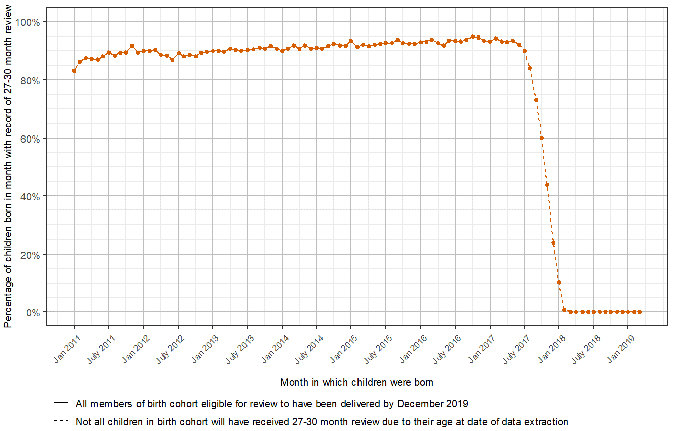Universal Health Visiting Pathway evaluation: phase 1 report - routine data analysis - implementation and delivery
The Universal Health Visiting Pathway was introduced in Scotland in 2015 to refocus the approach to health visiting in Scotland. This is the final report of four that provides findings about the implementation and delivery of the pathway as part of the national evaluation of Health Visiting.
27-30 month review
Reviews provided each month
The 27-30 month review was deliverable from 1 April 2013, and thus it was available for babies born from 1 January 2011 onwards. In Figure 14, seasonal variation in the number of reviews delivered is apparent, with a consistent trough every December, which is likely to be a reflection of fewer working days in that month as a result of the winter holiday period. From July 2013, the number of 27-30 month reviews undertaken is reasonably constant each month with a mean number of 4,265 per month.
Overall coverage
As noted for the 13-15 month review above, data extraction for Phase 1 took place in May 2020, but there is a time-lag between the review taking place and the information being available on the CHSP-PS system. Thus this extraction can be considered to provide complete information reliably on reviews undertaken by the end of December 2019. The review is recommended for children aged 27-30 months and should have taken place by the time the child is 32 months. Therefore the last birth cohort that can contribute complete review data to this data extraction is April 2017 (although in practice most children born by June 2017 will be included in this extract).
In Figure 15, review coverage for children born in January 2011 is 83.3%; this steadily increases to a maximum of 94.5% for children born in February 2017. The mean monthly coverage for children born between 1 January 2011 and 31 July 2017 is 91.0%. After this point data are likely to be incomplete.


Coverage stratified by SIMD quintile
Coverage of the 27-30 month review by level of deprivation is not presented in this report due to the unlinked nature of these data. This means that, when a child has moved house, we do not know where they have moved to, and whether this represents a change in the level of area deprivation in which the family are living. Discussions with PHS indicate that by 27-30 months and 4-5 years, respectively, a larger proportion of children have moved than was initially assumed; however, this is not equal across SIMD groups. For example, exploratory analyses by PHS indicate that, for children eligible for the 27-30 month review in 2016/17 (i.e. cohort extracted based on SIRS as at May 2017), 85% of children were born in the same health board area where they live now, whereas in the least deprived quintile this reduces to 77%. Within health boards we do not know the scale of movement across SIMD domains. For this reason, at the 27-30 month coverage, we refer readers to the PHS published statistics on coverage: Child Health Pre-School Review Coverage 22 February 2022.
Coverage in the PHS publication is based on the SIMD in which children currently live, as opposed to where they are born. Data indicate that review coverage between SIMD quintiles 1-4 increased in a similar pattern between 2013/14 and 2018/19: in 2013/14, coverage for these four quintiles was 86.0-87.5% and this increased to 91.0-92.3%. For children in the least deprived quintile, coverage in 2013/14 was a little higher (89.4%), and by 2018/19 it was 91.8% (i.e. within the range of review coverage for the other four quintiles).
Contact
Email: justine.menzies@gov.scot
There is a problem
Thanks for your feedback